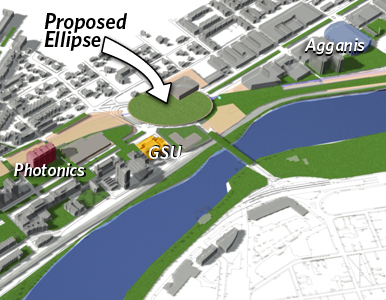statler
Senior Member
- Joined
- May 25, 2006
- Messages
- 7,938
- Reaction score
- 543
I guess this needs it own thread now.
LinkBU Today said:March 21, 2007
Study Sees New Campus Center Near BU Bridge
New transit hub would spur development
By Art Jahnke

The proposed ellipse (center) would pull together East Campus and West Campus and encourage development.
Last year Boston University leadership engaged the Toronto-based urban design firm Greenberg Consultants and CBT Architects of Boston to help envision the long-term development of the Charles River Campus. While Greenberg?s work is ongoing, the urban planner has proposed a key concept for the physical future of Boston University: a campus stretched along Commonwealth Avenue whose center is a grassy ellipse built over the Massachusetts Turnpike near the BU Bridge. Ken Greenberg, the principal of Greenberg Consultants, sees the ellipse as a powerful incentive for new academic, residential, and commercial development long into the future.
Although much of the imagined development would occur over decades, Greenberg?s study has some immediate implications, particularly for the development of transportation systems. It recommends, among other things, that state and city planners consider building near the BU Bridge a transportation hub that would connect the existing Commuter Rail line to the Green Line and to rapid transit buses traveling along the Urban Ring, a planned rapid transit route intended to link Boston?s universities and medical centers.
Boston University President Robert A. Brown says the proposed ellipse near the BU Bridge is an exciting concept for several reasons. The proposed transit hub would benefit the University and neighboring communities by providing faster and more convenient transportation to about 70,000 residents of Cambridge, Boston, and Brookline. Equally important, the hub would create an opportunity to design a more pedestrian-friendly flow of traffic in the area of the BU Bridge. That redesign would also encourage the development of commercial and retail space, as well as institutional space that would meet the needs of the University without requiring an expansion into neighboring communities.
Brown says the enormous long-term advantage of the ellipse is in providing a new center of gravity that would pull together East and West Campuses. Combined with efforts to reconnect with the Charles River, he says, the proposal could reknit communities that have long been split by highways and streets
Greenberg, whose projects include work on Brooklyn Bridge Park and Kendall Square, says the proposed ellipse and transit hub has the potential to create a vibrant community focal point in an area that is now a ?no-man?s-land.? He emphasizes that his yearlong study represents a strategic framework and not a fixed plan for development.
Gary Nicksa, BU vice president for operations, says ideas from the study involving connections to the Urban Ring have been presented to the state?s Executive Office of Transportation (EOT). University officials believed it was important, he says, in light of other proposals for Commuter Rail stops at alternative locations, for the state to consider the advantages of a location that could offer connections to the commuter train, the Green Line, and rapid transit buses, and that could unlock opportunities for commercial and retail development. Earlier this year, Harvard University proposed placing a Commuter Rail station at the current location of the Beacon Rail Yard, as part of Harvard?s large-scale expansion into Allston.
Nicksa says the University hoped the EOT would consider coordinating several current and proposed roadway improvement projects with the state?s master plan for the Urban Ring. He reports that the EOT and the state and local groups that had been briefed on the proposal have responded positively to the presentation?s vision for improved traffic flow, safety, and urban benefits.
Art Jahnke can be reached at jahnke@bu.edu.





